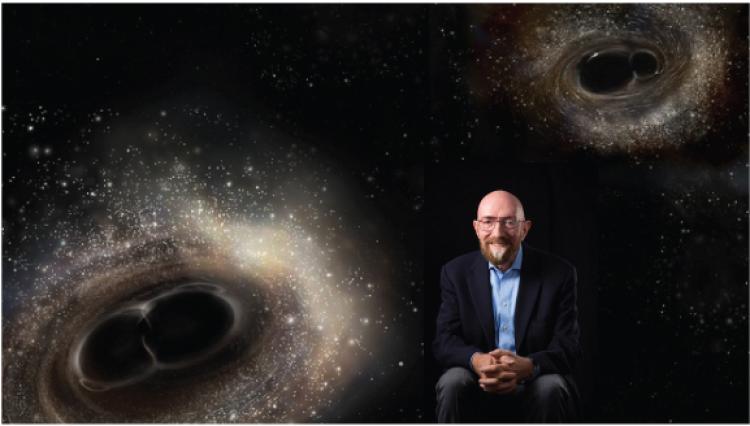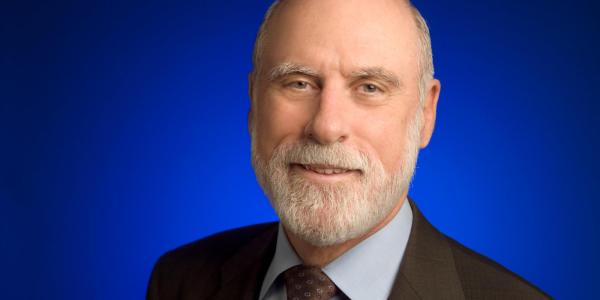Kip Thorne, pioneer in gravitational waves, creative force behind ‘Interstellar,’ to give 51st Gamow lecture at CU Boulder April 27
Albert Einstein predicted the existence of “gravitational waves” in 1916 based on his General Theory of Relativity, but it took a century to prove him correct.
On Feb. 11, 2016, a team of physicists from the Laser Interferometer Gravitational-Wave Observatory, or LIGO, Scientific Collaboration announced that the decades-long search had come to fruition with the detection of gravitational waves in September 2015.
It’s no exaggeration to say that Kip Thorne has been an indispensible connection between those two momentous events in the history of physics.
“Beginning about 50 years ago, I started to target the goal of using a new kind of radiation to explore the universe, gravitational waves, which are ripples in the fabric of space and time,” says Thorne, 76, Feynman Professor of Theoretical Physics, Emeritus at the California Institute of Technology.
Ever since, Thorne has dedicated his life to unveiling the secrets of what he calls “the warped side of the universe,” including black holes, wormholes through space and the fifth dimension, as a scientist, author and contributor to two of Hollywood’s most scientifically accurate science-fiction films.

Kip Thorne with an image from CalTech of two colliding black holes.
On April 27, Thorne will give the 51st George Gamow Memorial Lecture at Macky Auditorium on the CU Boulder campus on the topic of, “Probing the Warped Side of the Universe with Gravitational Waves: From the Big Bang to Black Holes.” The 7:30 p.m. lecture is free and open to the public.
The lecture, presented by the Department of Physics, is made possible by an endowment honoring Gamow, a former CU Boulder physicist who pioneered the concept that would become known as the Big Bang and authored many much-loved books popularizing science.
“We are honored to have Kip Thorne give the 51st George Gamow Memorial Lecture. Professor Gamow would have been enthralled by the recent discovery by LIGO of gravitational waves from colliding black holes,” says Paul Beale, professor of physics and chair of the Gamow Memorial Lecture Committee.
“Like George Gamow, Kip has made many seminal contributions to astrophysics, and he has demonstrated great skill at communicating the excitement and relevance of science to scientists and the general public. Most of the current generation of physicists and astrophysicists learned general relativity from the textbook Gravitation by Charles Misner, Kip Thorne and John Wheeler. Kip tells me that George Gamow inspired him to study physics. Many current and future scientists can say the same about Kip Thorne.”
The nitty-gritty of the universe’s “warped” side may lie beyond the ken of most lay science enthusiasts, but there is a nifty metaphor for black holes and gravitational waves: In Einstein’s General Theory of Relativity, the force of gravity results from the stretching of space and time by mass and energy, much like how a bowling ball will stretch a trampoline. Space and time near a black hole are stretched so much that not even light can escape.
Who: Kip Thorne, professor emeritus of physics at the California Institute of Technology and creative consultant for the film “Interstellar,” speaks on “Probing the Warped Side of the Universe with Gravitational Waves: From the Big Bang to Black Holes.”
When: 7:30 p.m. Thursday, April 27
Where: Macky Auditorium, CU Boulder campus
Tickets: Admission is free and open to the public
Info: colorado.edu/physics/gamow-lecture or 303-492-6952
Gravitational waves are like vibrations of the trampoline caused by motions of bowling balls, and the stretches and compressions of space and time propagate at the speed of light. Thorne long theorized that the collision and coalescence of two black holes would emit energy in the form of gravitational waves.
Thorne has spent more than half of his career focused on gravitational waves. In 1984, he co-founded LIGO with physicists Rainer Weiss from the Massachusetts Institute of Technology and Caltech’s Ronald Drever, to “open up gravitational waves as a tool for exploring the universe.”
Five years later, the three scientists successfully persuaded the National Science Foundation and Congress to fund the instruments for a search they were well aware might take decades. LIGO began its search when it became fully operational in 2002.
LIGO simultaneously operates two observatories more than 1,800 miles apart, in Livingston, La., and Richland, Wash. Using mirror arrays, a laser interferometer, and quantum entanglement, scientists searched for signs of gravitational waves.
“As the gravitational waves go by, they push the mirrors back and forth … and the lasers go back and forth,” Thorne says. “The mirrors are moving by just 1/100th of the diameter of a proton. … That is the very smallest, most accurate measurement of tiny, tiny motions and times that go back to the birth of the universe.”
Researchers concluded that the “ripples” detected by LIGO were produced by the collision and merging of two black holes, creating a single, more massive spinning black hole.
“We are now observing black holes in the flesh like they have never been observed before. We are learning observationally how black holes behave when they collide in the veritable storm of space and time,” Thorne says.
“What the team did is analogous to when Galileo turned his telescope to the sky for the first time and discovered the moons of Jupiter, which opened up astronomy. We’ve done this with a completely different kind of radiation and, just as Galileo’s discoveries had an impact many centuries into the future, this way of exploring the universe will continue to have an impact for a long time to come.”
Gravitational waves should also carry information about earliest moments of the Big Bang. “They are a tool to observe the earliest moments in the universe, almost back to the Planck time,” Thorne says. The Planck time of 10-43 seconds is the earliest moment when gravity became distinct from the other fundamental forces.
Described by Caltech physics colleague John Preskill as “a visionary scientist,” Thorne has received the Lilienfeld Prize of the American Physical Society, the Karl Schwarzschild Medal of the German Astronomical Society and the Albert Einstein Medal of the Albert Einstein Society in Berne, Switzerland, among other awards. In 2004, he was named California Scientist of the Year.
Thorne stepped down from his illustrious career at Caltech in 2009 to focus on continuing research, and writing books and movies.
The Wall Street Journal called his 1994 book for lay readers, “Black Holes and Time Warps: Einstein's Outrageous Legacy,” “Deeply satisfying … (an) engrossing blend of theory, history and anecdote.”
Thorne’s first brush with Hollywood came when he suggested to his friend, the late Carl Sagan, that he use a wormhole to transport scientist Ellie Arroway through space and time in the novel and film “Contact.” In 2005, after being introduced through a blind date arranged by Sagan, Thorne and Lynda Obst, then science editor at The New York Times Magazine, began writing the film treatment that would eventually become “Interstellar.”
Obst went on to become a film producer, and after years of typical Hollywood wrangling, the Christopher Nolan-directed movie was released in 2014. Much of the science was on the “warped side,” but scientists applauded along with a majority of critics and audiences.
“We built the science into that film,” says Thorne, who also served as executive producer. “That’s really only been twice before, with Arthur C. Clarke’s ‘2001’ and Carl Sagan’s ‘Contact.’”
Thorne recently met with a writer about writing a screenplay from a film treatment he co-authored with Obst and renowned physicist Stephen Hawking, his close friend of four decades. Whatever comes of it, he expects this will be his last dance with Hollywood.
“I can’t imagine not creating or trying to understand something new, but I’m interested in trying new things,” he says.



